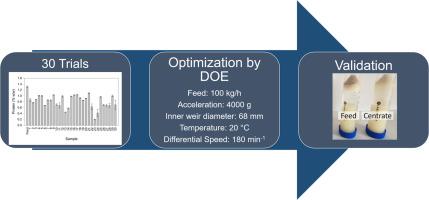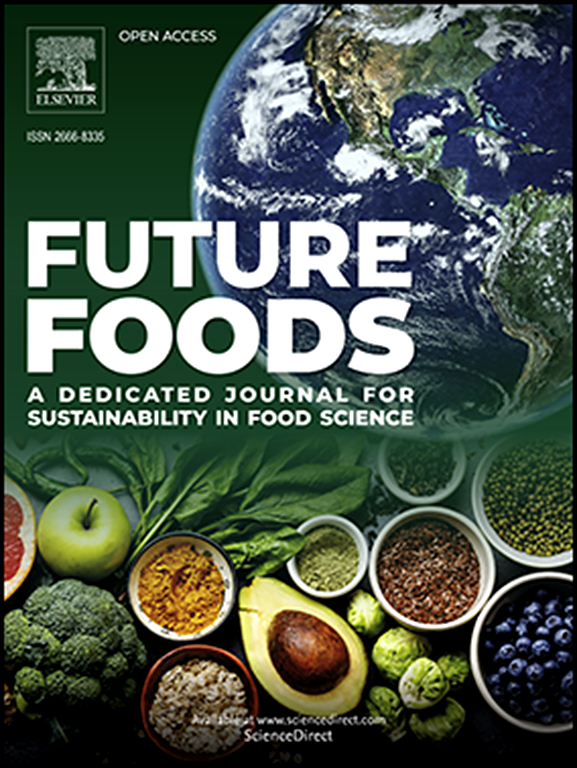从生产燕麦代乳品的蛋白质产量角度优化滗水器工艺
IF 7.2
Q1 FOOD SCIENCE & TECHNOLOGY
引用次数: 0
摘要
尽管燕麦代乳品具有多种营养益处,但其主要缺点之一是蛋白质含量较低。为了解决这个问题,我们研究了滗水器工艺对蛋白质产量的影响。通过 30 次实验设计,确定了加速度、进料、进料温度、内堰直径和差速对分离过程的影响。实验结果用于计算理想参数。因此,4,000 克的加速度、20 千克/小时的进料量、20 °C的温度、68 毫米的内堰直径和 180 分钟/1 的差速可产生最高的干物质理论蛋白质含量(14.22 % w/w),相当于 98.2 % 的蛋白质产量。根据计算参数进行的验证实验得出,干物质蛋白质含量为 11.63 ± 0.14 %(重量比),蛋白质绝对含量为 1.00 ± 0.01 %(重量比),蛋白质产量为 81.3 ± 1.70 %。中心液中没有深色颗粒,证明已充分分离了不需要的固体。SDS-PAGE 进一步证明,没有一个蛋白质部分被完全分离。总之,为了获得较高的蛋白质产量,滗水器工艺的参数应仔细设定。本文章由计算机程序翻译,如有差异,请以英文原文为准。

Optimization of the decanter process in terms of the protein yield for the manufacture of an oat-based milk substitute
Even though oat-based milk substitutes offer numerous nutritional benefits, one of their major disadvantages is the low protein content. To overcome this issue, the impact of the decanter process on the protein yield was investigated. A design of experiments with 30 experimental runs was performed to determine the influence of acceleration, feed, feed temperature, inner weir diameter, and differential speed on the separation process. The results were used to calculate the ideal parameters. Accordingly, an acceleration of 4,000 g, a feed of 20 kg/h, a temperature of 20 °C, an inner weir diameter of 68 mm, and a differential speed of 180 min−1 resulted in the highest theoretical protein in dry matter content (14.22 % w/w) corresponding to a protein yield of 98.2 %. The validation experiments with the calculated parameters led to a centrate with a protein in dry matter content of 11.63 ± 0.14 % (w/w), an absolute protein content of 1.00 ± 0.01 % (w/w), and a protein yield of 81.3 ± 1.70 %. The centrate was free of dark particles confirming an adequate separation of undesired solids. SDS-PAGE further proved that no protein fraction was completely separated. In conclusion, the parameters of the decanter process should be set carefully in order to achieve a high protein yield.
求助全文
通过发布文献求助,成功后即可免费获取论文全文。
去求助
来源期刊

Future Foods
Agricultural and Biological Sciences-Food Science
CiteScore
8.60
自引率
0.00%
发文量
97
审稿时长
15 weeks
期刊介绍:
Future Foods is a specialized journal that is dedicated to tackling the challenges posed by climate change and the need for sustainability in the realm of food production. The journal recognizes the imperative to transform current food manufacturing and consumption practices to meet the dietary needs of a burgeoning global population while simultaneously curbing environmental degradation.
The mission of Future Foods is to disseminate research that aligns with the goal of fostering the development of innovative technologies and alternative food sources to establish more sustainable food systems. The journal is committed to publishing high-quality, peer-reviewed articles that contribute to the advancement of sustainable food practices.
Abstracting and indexing:
Scopus
Directory of Open Access Journals (DOAJ)
Emerging Sources Citation Index (ESCI)
SCImago Journal Rank (SJR)
SNIP
 求助内容:
求助内容: 应助结果提醒方式:
应助结果提醒方式:


